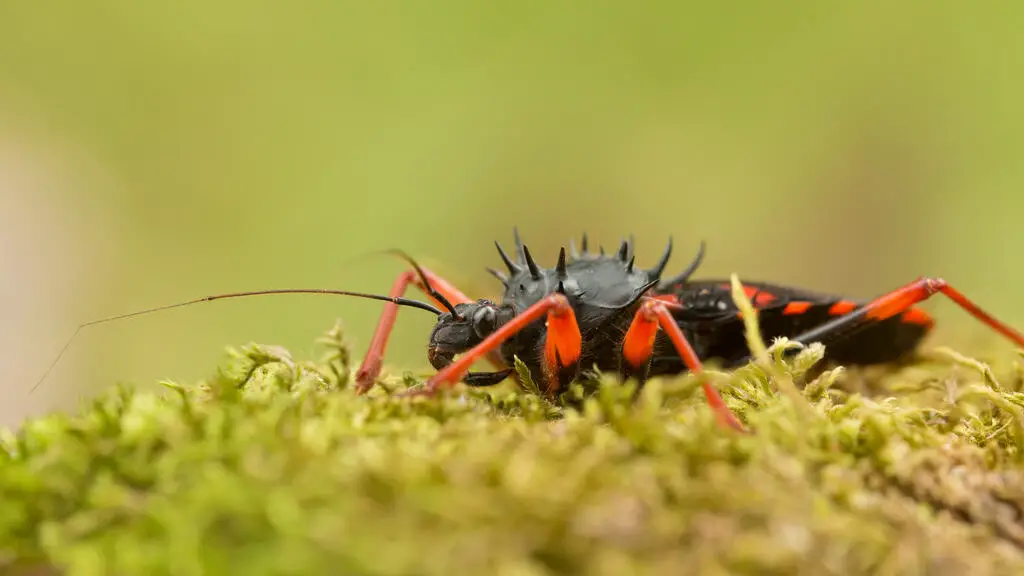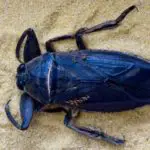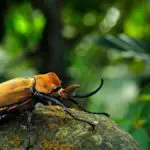Horrid King assassin bugs’ fascinating hunting behavior and unique appearance have made them desirable for exotic pet keepers. If you plan to keep a Horrid King assassin bug, you are at the right place. In this article, I’ll teach you how to care for the Horrid King assassin bugs.
To keep Horrid King assassin bugs, place them in a large container with a secured lid and proper ventilation. Substrates are optional. Feed the assassin bugs 2-3 times a week with feeder insects. Additional water and temperature and humidity regulation are not required.
As described above, keeping Horrid King assassin bugs is not as horrible and difficult as it seems. Continue reading for more details.
Introduction to Horrid King Assassin Bugs

The Horrid King assassin bug is scientifically known as Psyttala horrida. It is a species of large, predatory assassin bug native to tropical western Africa.
The Horrid King assassin bug is the largest known assassin bug, growing up to 4.5 cm in body length. It is best known for its striking appearance – a spiny, black and red body.
Like other assassin bugs, the Horrid King assassin bugs are ambush predators. They wait quietly in the vegetation for their prey, and snatch them with lightning speed.
While holding their prey with their strong legs, the assassin bugs use their needle-like mouthparts called the rostrum to pierce into the prey. Saliva is injected to paralyze and liquefy the internal organs of the prey. After that, the assassin bug sucks up the liquefied nutrients.
The male Horrid King assassin bugs can make warning sounds by rubbing their rostrum against their body. This is called stridulation, which is also used to attract females.
While the Horrid King assassin bugs are closely related to the bugs that transmit life-threatening Chagas disease, they are not disease carriers. Having said that, they can still inflict painful stings.
Is the Horrid King Assassin Bug the Right Pet for Me?
If you are looking for a cool, non-cuddle pet, and willing to go through the hassle of feeding live insects to your pet once every few days, the Horrid King assassin bugs are the right pets for you.
However, if you need a pet insect that you can play with, an assassin bug is not the right option for you. You should get non-biting pets like stick insects or beetles.
Getting the Horrid King Assassin Bugs
The Horrid King assassin bug is not as common as other pet insects. It is unlikely to find them in local pet stores. Most of the time, online stores are your best bet.
Try to buy young nymphs instead of adult bugs. An adult Horrid King assassin bug can live for 1-2 years. There is no way to ascertain the age of the adult, which could be nearing the end of its lifespan when you buy it.
Housing Horrid King Assassin Bugs
The Horrid King assassin bug can be housed in any transparent enclosures with a proper lid to prevent it from escaping, and vents to allow adequate ventilation. Multiple bugs can be housed in the same container. Cannibalization is minimal, as long as you provide them sufficient food and space. A 5 gallon tank is sufficient to house 20-30 of them.
Although adult assassin bugs have wings, they seldom fly. On top of that, they spend most of their time hiding instead of roaming around. Hence, escaping is unlikely. Having said that, it is still crucial to use a properly secured enclosure.
Decorate the enclosure with barks, twigs and rocks. This provides hiding places for the assassin bugs. Remember, they are nocturnal, and love to hide in darkness.
Substrates
Unlike other pets, such as giant millipedes, substrates are not crucial for the survivorship and wellbeing of the Horrid King assassin bugs. However, it is still a good idea to put some substrates so that it takes longer before the enclosure becomes dirty and requires cleaning.
You can use anything for substrates, ranging from potting soil, sand, coir, hays etc. Do not mix the substrates with water!
Water
If you feed them frequently, your P. horrida will obtain sufficient water from their prey. No additional water is required.
If you are feeding your assassin bugs at a longer interval, or if you are worried that they do need water due to the hotter and drier climate where you are, there is no harm giving them water.
You can do so by placing a shallow water dish in the enclosure. Some hobbyists mist the enclosure every few days so that the assassin bugs can drink on the water droplets from the mists.
Lighting, Temperature and Humidity
The Horrid King assassin bugs are nocturnal creatures. They do not require additional lighting. However, you can install a display light to make observation easier and enjoyable.
The Horrid King assassin bugs can be kept between 20-28 °C (~68-82 °F). Heating is not required unless it is too cold (eg. in the winter).
In terms of humidity, this species do well under regular humidity. No humidity regulation is required.
Feeding
Feed your Horrid King assassin bugs with 2-3 crickets or roaches, 2-3 times a week. The crickets or roaches should be around the size of your bugs, or smaller. While the assassin bugs have no issue handling slightly bigger prey, it is often easier and safer to offer them smaller one.
Often, it is a good idea to maintain a small colony of feeder crickets or feeder roaches to support the needs of your predatory bugs.
After your assassin bugs are done feeding, remove the dead carcasses of the prey using tweezers. Do not leave the carcasses for too long, or it may promote the growth of molds and mites.
Unless your bugs are molting, or the feeder insects may overwhelm your bugs, you can leave the live feeder insects in the enclosure for 1-2 days (before they die from starvation or desiccation).
Recommended Resources and Supplies
Here are my recommended resources and supplies that you can consider getting for your Horrid King assassin bugs. I’ll earn a small commission from eligible purchases you make after clicking those links. It helps me maintain this site without additional cost to you.
Best Read – Assassin Bugs, Waterscorpions and other Hemiptera by Orin Mcmonigle

If you are looking for books about keeping assassin bugs, this is probably the only one that you can find. This book covers not only assassin bugs, it also covers other interesting pets such as the water bugs. The author, Orin Mcmonigle, has not only outlined the science you need to know about assassin bugs, but also the practical part of it from his experience handling arthropods for years. In short, this is the must-have and one-and-only book for assassin bug enthusiasts.
Other Supplies
Molting Care
The Horrid King assassin bugs undergo incomplete metamorphosis. The immature bugs molt 5 times to turn into adults.
Prior to molting, the assassin bug will hide somewhere and remain static. It will also stop feeding. Never touch or disturb your bugs when they are molting, because they are extremely vulnerable at this stage.
Sometimes, the assassin bug may find a vertical surface, and molt with its head facing downward. They may also take an upside-down position for molting (as illustrated in the above photo), if they feel comfortable.
After molting, it takes 1-2 days before the exoskeleton of the bug becomes fully hardened. They resume feeding only after their exoskeleton is hardened.
Generally, you do not have to worry too much about molting care. More often than not, you will not see them molting, unless you observe them daily.
Handling
Handling the Horrid King assassin bug with bare hands is not recommended, because it can inflict a painful bite. While they rarely bite, it is best not to take the risk. A few hobbyists reported venom spraying in this species, which is dangerous if it gets into your eyes. However, it is rare.
Always use a pair of long tweezers when handling the Horrid King assassin bugs. Try to coax them with the tweezers whenever you need to move them during cleaning. The assassin bugs are generally docile. They tend to leave you alone when you clean the enclosure, instead of actively attacking you.
Breeding
Breeding of P. horrida is very straightforward. Simply keep the adult male and female bugs in the same enclosure, and they will readily breed.
So, how do you know if the Horrid King assassin bugs are adults? Simple! If they have wings, they are adults.
What about the sex of your assassin bugs? The underside of the abdomen of a male P. horrida is smooth and pointy at the tip, while the female has a square pattern at the underside of her abdomen.
A few weeks after mating, the females of P. horrida will start to lay eggs in substrates. In the absence of substrates, they may even lay eggs in the carcasses of their prey. The eggs are ellipsoid and dark brown.
Hatching the Eggs
Carefully collect the eggs from the substrates and transfer them into a deli cup containing moist substrates. The eggs should hatch within a few weeks. Without the moist substrates, the hatchability of the eggs will greatly reduce.
Caring for the Young Nymphs
Newly hatched baby Horrid Kings are small and fragile. They have brilliant yellow legs, which will turn black as they molt. Using a brush, carefully coax them into another enclosure. Add some barks and twigs to increase the surface area for your bugs to move around and hide.
Remember, multiple assassin bugs can be housed together in the same enclosure. You can even place the young nymphs together with their parents if you want. This species is sub-social, where the adults will take care of their young to a certain extent.
Feed the young nymphs every other day with flightless fruit flies, pinhead crickets or roaches of similar sizes or smaller. Remove the leftovers regularly.
If you follow this feeding regime, no water or misting is required. The nymphs will get enough water from their food.
As the nymphs molt and grow bigger, transfer them to a bigger enclosure.


